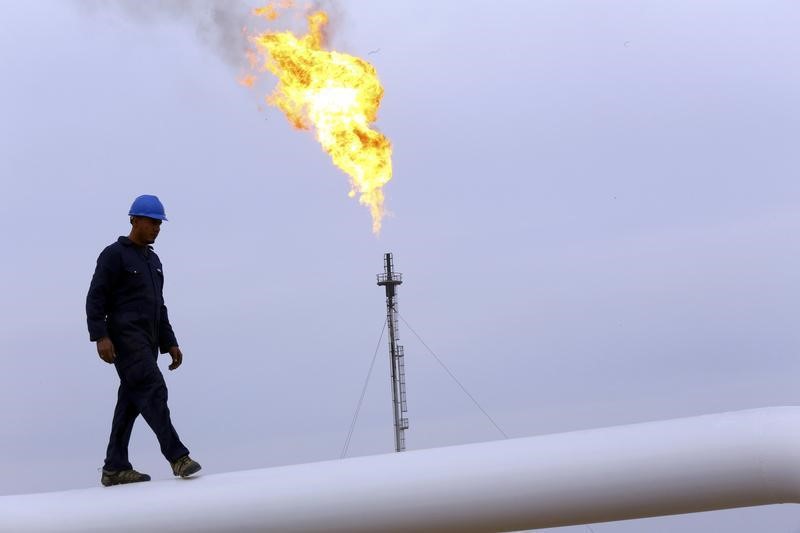Investing.com — Crude prices fell more than 2% Wednesday as those long the market took meaningful profit the first time since a five-week rally in oil began.
The slump, interestingly, came on a day when the Energy Information Administration reported an epic drop in weekly U.S. crude stockpiles, after weeks of citing paltry inventories despite OPEC leader Saudi Arabia claiming to be cutting an additional million barrels per day from its production since the start of July that would take 2.5 million daily off its output.
More interesting than the EIA report was a story suggesting the Saudis might be playing a deception game with their production cuts by “quietly selling” additional oil to the so-called PNZ, or Partitioned Neutral Zone, region it shared with Kuwait that escapes the radar of the broader market.
“Saudi Arabia has a long history of doing this, so it’s no surprise that it’s looking to increase its oil sales through extra production from the PNZ [Partitioned Neutral Zone shared with Kuwait], particularly as the area’s so off the radar, and Russia has been doing the same with its oil for months,” OilPrice.com quoted a senior source in the European Union energy security complex as telling it in a story it carried late Tuesday.
According to the source, although the joint statement by Saudi Arabia and Kuwait on 9 July said that accelerated efforts to complete joint oil projects in the PNZ are to meet local energy demands, in reality they are to provide Saudi Arabia with off-the-radar – ‘dark inventory’ – oil that it can sell through various backdoor methods at currently inflated prices, without being seen to break its official OPEC+ quota.
“To me, the PNZ story is also not surprising as deceiving the market on production cuts is OPEC’s number one game, since the days of yore,” said John Kilduff, partner at New York energy hedge fund Again Capital. “There’s no doubt that this story has contributed somewhat to the downside in oil today, aside from real profit-taking that’s going on.”
U.S. West Texas Intermediate, or , crude settled Wednesday’s trade down $1.88, or 2.3%, at $79.49 per barrel. It was the largest one-day drop in crude prices since a 4.4% tumble on June 12 that drove WTI to $66.80 per barrel — before the five-week rally that gave the U.S. crude benchmark a near 16% return for July.
London-based crude settled down $1.71, or 2%, at $83.20. The global oil benchmark gained nearly 14% for July.
Earlier on Wednesday, the U.S. Energy Information Administration, or EIA, reported that domestic dropped by 17.049M barrels during the week ended July 28, versus forecasts for a decline of just 1.367M and the drop of 0.6M for the week to July 21.
Over three previous weeks, the EIA had been reporting lackluster draws on the U.S. petroleum complex despite Saudi Arabia claiming to have taken an additional million barrels per day off its daily production.
Analysts have said that while it wasn’t logical to expect a barrel-for-barrel correlation between changes in Saudi crude exports and U.S. inventories, the EIA as the world’s premier provider of transparent and comprehensive data on energy, had to be capturing the shifts in the global supply situation at least in its weekly data — notwithstanding the apparent Saudi “game” on the PNZ front.
“What this also means is that the EIA came through and the Saudis probably did not,” said Kilduff, the hedge fund partner.
In its latest Weekly Petroleum Status Report, the EIA also said U.S. crude oil refinery inputs averaged 16.5M barrels per day during the week ending July 28 — up 0.04M more than the previous week’s average.
Refineries operated at 92.7% of their operable capacity last week, the EIA said, adding that gasoline production increased as well last week to an average of 9.8M per day along with distillate fuel production, which averaged 4.9M daily.
On the front, there was a build of 1.481M barrels over the 0.786M-barrel decline in the previous week. Automotive fuel gasoline is the No. 1 U.S. fuel product.
With , there was a drop of 0.796M barrels versus the prior week’s deficit of 0.245M. Distillates are refined into , diesel for trucks, buses, trains and ships and fuel for jets.
Read the full article here












